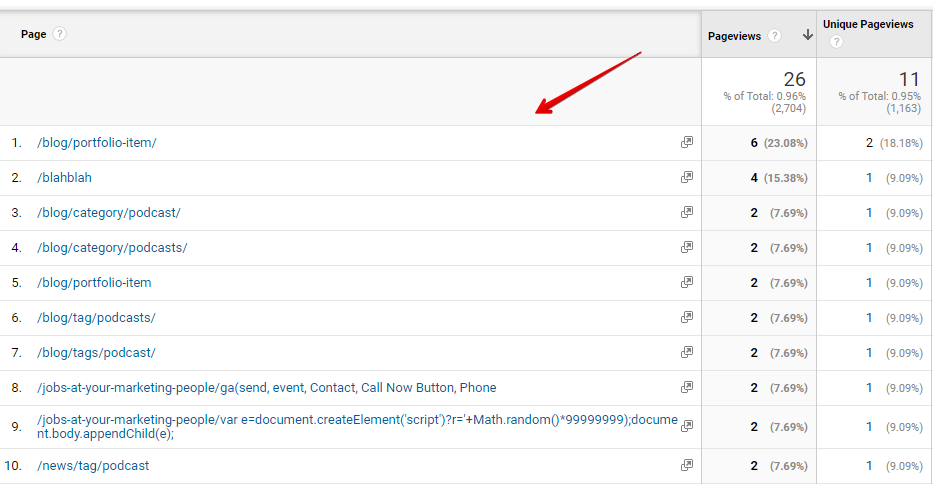Sections
Did You Know You Can Find Website Bugs Using Google Analytics?
If you’re like most companies, you likely think of Google Analytics as a great, free tool for tracking and reporting on your website’s traffic. And while it definitely performs these tasks, the solution can be used for so much more.
Once you get to know advanced features in Google Analytics, you can actually use the solution to perform a free website audit to find bugs on your website such as broken pages, issues with site performance in certain browsers, and whether or not your site is displaying properly on top devices.
Continue reading to learn 7 insider tricks and tips for how to use Google Analytics to audit your website and find website bugs.

#1 Find Broken Pages and Bad URLs
Once you have viewers on your website, you want them to stay there and learn all about your brand and the products or services you offer. That’s what makes broken pages and bad URLs so detrimental – they add friction to your customers’ browsing experiences and may cause them to leave your website altogether.
Each visit to the web standard “404 Page Not Found” landing page is tracked in Google Analytics using different web addresses, which makes identifying the bad page almost impossible. But our insider trick is not to look at the page URL, but the Page Title.
In Analytics, go to Behavior > Site Content > All Pages. Switch the Primary Dimension to Page Title.

Add the text “Page not found” into the filter box. The results will be a report with a single row stating “page not found.”
Now, here comes the magic.
Click on the report for a drilled-down list of the URL and all pages with that specific, unique Page Title. You now have a complete list of bad URLs that have been visited within your specified date range. You’ll see the pages’ names in the “Page” column. Now you can act by either redirecting these pages or creating new content for them.

#2 Find Broken Internal Links Between Your Webpages
To find out if you have broken internal links on your website, go to Behavior > Site Content > Page Title dimension, filter for “Page Not Found” > Drill down > Navigation Summary – Previous Page Path.
Follow the steps listed in tip #1 to get to the report of your broken links. Next, choose any page in the Page column and select the “Navigation Summary” tab. Look specifically at the pages in the “Previous Page Path” list.
This will tell you which pages your visitors were on immediately before they came to a bad URL, which tells you that you have a broken internal link that needs to be fixed.
#3 Determine if Your Site is Performing Well on Popular Web Browsers
Your customers and leads use a variety of different website browsers. For a seamless website viewing experience for everyone, you need to make sure your website is performing well on all of them.
To determine your website performance per browser go to Audience > Technology > Browser & OS report. This report will show you both your bounce rate and your bounce rate per browser.
From this report, switch to the “Comparison View.” This will show you the percentage bounce rates per browser type. Ideally, they should be pretty close to equal, or at least within a few percentage points of each other.
But if one browser’s bounce rate is significantly higher than the others, it’s a good clue that your website isn’t performing properly in that web browser. If there’s a browser that pops out, that’s a good indicator that you need to perform further browser testing using another application.
#4 Find Out if Your eCommerce Shopping Cart is Broken on Certain Web Browsers
If you run an eCommerce website, you want your shopping experience to be as easy as possible for your customers. That’s why it’s so important that you follow this tip to use Google Analytics to discover if your shopping cart is broken in a particular browser.
Go to Audience > Technology > Browser & OS (Conversion Rate). This page will show you the percentage of shoppers who are converting per browser type.
You could reasonably expect that each browser’s conversion rate would be similar, within a few points of each other. But if one browser has a much lower conversion rate, that could be a sign that your shopping cart isn’t working in that browser.
#5 Determine if Your Site isn’t Displaying on Certain Popular Devices
With more and more web browsing and searching happening on mobile devices, it’s important that your website displays properly on them. Check your mobile device bounce rate by going to Audience > Mobile > Devices.
Next, do these steps:
- Create a “Mobile Device Model” segment.
- Look at the exit page report for your mobile website visitors.
If you see a device that has a higher bounce rate than others, your website might not be displayed on it properly. Check around your office for someone who has that specific device, and see how your website appears on it.
#6 Set Up a Custom Alert To Tell You if There’s a Sudden Drop in Website Traffic
You’ll want to know if suddenly your website traffic comes to a screeching halt. Thankfully, Google Analytics makes this easy to do by setting a custom alert.
From the Admin interface, go to custom alerts and set up an alert for “Traffic Drop.”
#7 Determine What Content to Write Based on Internal Search Bar Results
Knowing what your customers are searching for is a great way to know their intent on your website. And if their search results come up empty, that’s a great way to make a to-do list of content to create.
To find search results that yield zero pages, go to the Site Search > Search Terms report. Here, you’ll see a list of the search terms your website visitors have entered into your search box.
Next, go to the comparison view, and look for terms that have a high percentage of Search Exits. These are likely pages that don’t have any related content and can be a great way to build out a content calendar for search terms that make sense for your business.
Follow Us For More Marketing Tips and Tricks
Interested in learning more marketing tips and tricks? Follow us on social media @yourmarketingpeople on Instagram, Facebook, and YouTube or @YMP_agency on Twitter.







